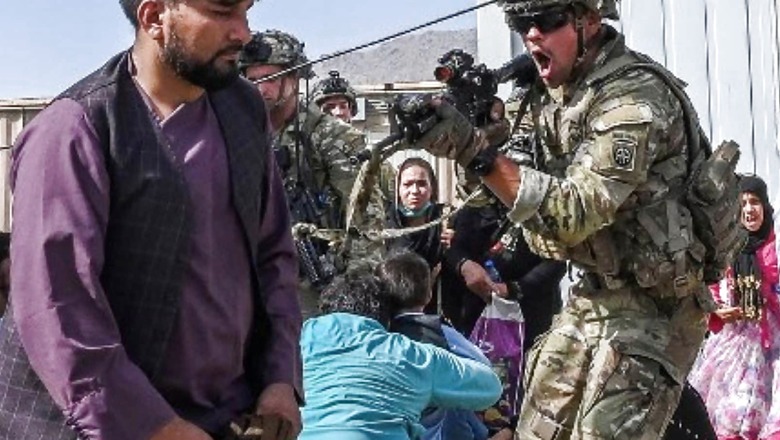
views
After the Taliban’s takeover of Afghanistan, articles on how militant rule on the war-ravaged country would completely destroy women and children’s lives flooded the media. However, little to no mentions have been made on the humongous effect the current reality will have on men.
According to Hebh Jamal, an advocate on education inequality, this is the result of the fractured perspective of the West and its media, which with its conscious erasure of men’s humanity, has used a one-sided story to justify their own ‘invasion’ of Afghanistan, and subsequent actions.
Amid criticism of US President Joe Biden on the withdrawal of Americans troops from the region, Western media reports had detailed how bad life would be from now on for Afghan women. However, no mentions were made on how their lives were under a different kind of war the nation faced under US control – drone attacks, night raids, political instability, etc. This, accompanied by viewing men – also civilians – as mere ‘radicalisation threats’ pushing aside their narratives. News18 takes a dive into this contentious portrayal, and what it could mean:
What is Embedded Feminism, and How Does it Play Into the Situation Now?
In her article, Jamal skilfully explains why America and the West have been interested in “saving” Afghan women.
After George W bush’s decision on the “war on terror” in Afghanistan the situation of Afghan women under the Taliban became a popular talking point in America, she explains. In a radio address to the nation, then-First Lady Laura Bush criticised the “severe persecution of women in Afghanistan” and said that the “battle against terrorism is also a war for the rights and dignity of women.” Jamal argues that the The US government utilised feminist terminology when discussing Afghanistan, not because it cared about Afghan women, but because it believed it could gain popular support for its invasion.
With her conceptual framework of the concept of ’embedded feminism’, Krista Hunt, a Canadian gender researcher, analysed the gendered aspect of the US-led invasion of Afghanistan in 2001 and the US government’s practise of justifying the War on Terror in the eyes of the public.
Hunt defined it as “the inclusion of feminist ideology and feminist activists into political agendas that purport to serve the interests of women but ultimately subordinate and/or sabotage that goal.” Hunt invented the term embedded feminism to relate to the US Department of Defense’s “embedded journalism” or “embedded media” technique, which became popular in media coverage of the 2003 invasion of Iraq.
‘They Never Listened Before’: US-led Invasion of Iraq
Right before the US-led invasion of Iraq, the US administration and media played up the torturous treatment of women under Sadam Hussein’s regime. However, the timing of this sudden interest in the plight of Iraqi women can not be overemphasized, Nadje Al-Ali argued in a report. Ali said that for decades, many Iraqi women activists in the US and UK, including Act Together, the organisation Ali co-founded, as well as many exiled women, such as members of the Iraqi Women’s League, had tried to raise awareness about Saddam Hussein’s systematic abuse of human and women’s rights, atrocities linked to the Anfal campaign against Kurds, and the impact of economic savagery.
But Amal K., a London-based lawyer, told Ali in 2004 that the attention was short-spanned. “We wrote so many letters and we organized many events: talks, workshops, seminars, demonstrations. They did not want to know. They were just not interested. It was only in the run up to the invasion that the governments started to care about the suffering of Iraqi women,” she said.
Men are Also Victims of War, and They Have Been in Afghanistan
After the Taliban took over Kabul, civilians were desperate to escape. Visuals of men dropping to their deaths from planes that they climbed onto, shocked and horrified. Why then, is the media coverage of the West on the horrors of war so gendered? Because America’s treatment of Afghan men also also been so under its own supported regime, according to reports. Jalal in her report argues that most American soldiers in Afghanistan, like their political leaders and generals, made no attempt to distinguish male Afghan civilians from Taliban combatants. As a result, they often used their firearms against unarmed Muslim men. She brings to the fore examples of Mullah Habibullah and cab driver Dilawar who, she said were “blameless victims” of America’s war on terror in Afghanistan.
Bagram Base Torture
In 2005, the New York Times obtained a 2,000-page United States Army investigation report in 2005 regarding the homicides of the two unarmed civilian Afghan prisoners by US military personnel in December 2002 at the Bagram Theater Internment Facility and general prisoner treatment.
Habibullah and Dilawar, the two inmates, were repeatedly shackled to the ceiling and abused, resulting in their deaths. Both of the detainees’ deaths were deemed homicides by military coroners. Autopsies indicated serious injuries to both convicts’ legs, comparing it to being driven over by a bus. In 2005, seven troops were accused.
Read all the Latest News , Breaking News and Ukraine-Russia War Live Updates here.















Comments
0 comment